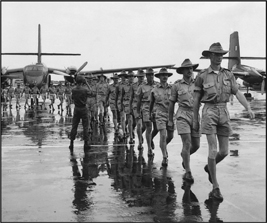
From 1965 to 1972, the United States supplied most of the combat forces in Vietnam and did most of the fighting in the country. But they did not fight alone. In order to get international support for America’s involvement in the Vietnam War, President Johnson made an official call for “free world military forces” to forge an alliance of “many flags” to fight the Communists. A total of forty countries answered President Johnson’s call and sent support into Vietnam. The most significant military support came from Australia, New Zealand, and South Korea.

A unit of Royal Australian Air Force troops disembarking from an airplane at Tan Son Nhut airport, Saigon.
Australia became involved because it was concerned that a Communist Vietnam would threaten democracies throughout Southeast Asia, particularly Indonesia, which is very close to the northern coast of Australia. New Zealand, though farther away, sent troops for the same reason. South Korea sent troops because of its recent, bitter experience with Communist invasion by the North Korean Army during the Korean War.
The Australian forces were stationed in Phuoc Tuy Province just southeast of Saigon. With their aggressive patrolling, they soon became a major threat to Viet Cong in the area.
The top Communist leadership in the province decided to “teach the Australians a lesson,” one that would also send a message to local villagers. That lesson began on August 17, 1966, and was called the Battle of Long Tan. Australian patrols suddenly found themselves ambushed by large concentrations of Viet Cong, who repeatedly struck at the outnumbered Australians.
Private Harry Esler remembered thinking during one attack that “[i]t was just like a kangaroo shoot. They were coming in waves. They were blowing bugles off to the left, in front, and across to the right. I remember thinking, ‘I wish I had a set of bagpipes here. I’d put the fear of [the Lord] up those blokes!’”
Despite the odds, the Australians refused to give up. The fighting continued throughout the day and into the evening. The following day, the Australians discovered a battlefield littered with enemy dead.
The lesson the Viet Cong had attempted to teach the Australians had cost them 245 men. The Australians suffered only seventeen dead and nineteen wounded. It was a humiliating defeat for the Viet Cong.